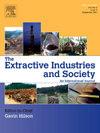驱散战争迷雾:从下方评估军事温室气体排放
IF 3.6
2区 社会学
Q2 ENVIRONMENTAL STUDIES
Extractive Industries and Society-An International Journal
Pub Date : 2025-03-31
DOI:10.1016/j.exis.2025.101654
引用次数: 0
摘要
世界上军队的温室气体排放量占全球温室气体排放总量的5.5%,然而,各国政府仍然没有在国际气候协议中报告这些排放量的要求。因此,研究人员只能靠自己来评估军事排放。这似乎是一项令人难以置信的艰巨任务。在冲突期间,数据的缺乏更为明显,在冲突期间,报告相对不存在。本文提出了一个新的框架,用于检查军事供应链的温室气体排放,包括由于供应链复杂性而难以获得排放数据的情况,或者在国家安全的幌子下故意隐瞒数据的情况。我们对美国军方在第二次伊拉克战争(2003-08)期间使用混凝土的供应链碳进行了实证研究,以证明其实用性。混凝土有大量的碳足迹,美国军方用大量的混凝土来建造防护墙、检查站、基地和掩体。这项工作提供了测量军事供应链中碳含量的工具,加强了最近对强调军事环境基础设施足迹核算的标准化框架的呼吁。本文章由计算机程序翻译,如有差异,请以英文原文为准。
Parting the fog of war: Assessing military greenhouse gas emissions from below
The world's militaries account for up to 5.5 % of total global greenhouse emissions, yet there is still no requirement for governments to report these emissions in international climate agreements. Researchers are therefore left on their own to assess military emissions. This may seem like an incredibly daunting task. The lack of data is even more stark during periods of conflict, where reporting is relatively non-existent. This article sets out a novel framework for examining greenhouse gas emissions from military supply chains including situations where emissions data are difficult to acquire due to supply chain complexity, or when data are purposefully held back under the guise of national security. We provide an empirical study of supply chain-based carbon from the US military's use of concrete during the Second Iraq War (2003–08) to demonstrate its practicability. Concrete has a massive carbon footprint, and the US military uses a lot of it for protective walls, checkpoints, bases and bunkers. This work provides the tools to measure carbon embodied in military supply chains reinforcing recent calls for standardised frameworks emphasising the accounting of military environmental infrastructure footprints.
求助全文
通过发布文献求助,成功后即可免费获取论文全文。
去求助
来源期刊

Extractive Industries and Society-An International Journal
ENVIRONMENTAL STUDIES-
CiteScore
6.60
自引率
19.40%
发文量
135
 求助内容:
求助内容: 应助结果提醒方式:
应助结果提醒方式:


